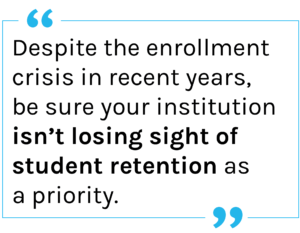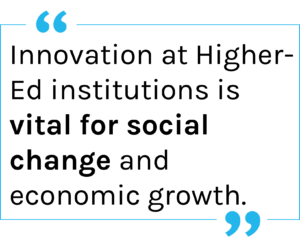Measuring the impact of HigherEd using data analytics

Colleges and universities have a huge impact on the world around them. From their relationships with surrounding towns, cities, and states to their contributions to the global research community, higher education institutions make a difference. How can your institution harness data analytics to measure or increase its broader impact?
Student outcomes
Students are key to the impact of HigherEd. It is well-documented that students gain a great deal from pursuing education beyond high school, including greater career opportunities and higher long-term earnings. These benefits go beyond the individual, however. College and university graduates contribute to economic growth, which helps reduce poverty. They also tend to be more active in their communities and in politics, and are more likely to volunteer and to vote. Societal benefits like these show the broader impact of HigherEd on the world.
However, for both students and societies to reap the rewards of a college degree, it’s not enough to just get students to enroll. Students who attend college but fail to graduate don’t get the same benefits as their peers who graduated, even if they completed most of their courses or credits. So, to have the greatest impact on students and on the world, it’s vital that your institution focus not just on attracting students, but on retaining them.
 Despite the enrollment crisis in recent years, be sure your institution isn’t losing sight of student retention as a priority. There are many ways you can dive into data analytics to better understand opportunities to increase retention and positive student outcomes at your institution. For instance, some colleges are using targeted advertising to attract students with partial degrees who could benefit hugely from finishing school. Other institutions are diving into the data to uncover warning signs that may precede a student dropping out. Georgia State University, for instance, launched a program that utilizes predictive analytics to ensure that struggling students get the support they need to graduate.
Despite the enrollment crisis in recent years, be sure your institution isn’t losing sight of student retention as a priority. There are many ways you can dive into data analytics to better understand opportunities to increase retention and positive student outcomes at your institution. For instance, some colleges are using targeted advertising to attract students with partial degrees who could benefit hugely from finishing school. Other institutions are diving into the data to uncover warning signs that may precede a student dropping out. Georgia State University, for instance, launched a program that utilizes predictive analytics to ensure that struggling students get the support they need to graduate.
To enable a program like this, your institution should start by breaking down data silos to ensure that all stakeholders can access the information they need to understand the entire student journey, and embracing an analytics solution that offers actionable insights across your entire campus.
Research
Faculty and student research are core activities at many HigherEd institutions. Academic research has led to important discoveries and inventions, far beyond what many people realize. For instance, university research is credited with the discovery of the insulin gene, antibiotics, GPS, the nicotine patch, and countless more. Many functions of the world today were made possible by academic research, and innovation at higher education institutions is vital for social change and economic growth.
Academic research is led by your institution’s faculty body, but they have complex workloads that often take them away from dedicated research time. Between teaching, preparing course materials and curricula, advising and meeting with students, service committees, and administrative work, research time can be tough to fit in—especially when that research is dependent on grants. Recent budget cuts at many institutions have made grants even more vital, but applying for grants is a barrier for many faculty members. The applications take up huge amounts of time and there is no guarantee of a positive result. In fact, most grant applications are rejected. One study at a teaching college demonstrated that the single largest obstacle for faculty seeking external funding was time.
research time. Between teaching, preparing course materials and curricula, advising and meeting with students, service committees, and administrative work, research time can be tough to fit in—especially when that research is dependent on grants. Recent budget cuts at many institutions have made grants even more vital, but applying for grants is a barrier for many faculty members. The applications take up huge amounts of time and there is no guarantee of a positive result. In fact, most grant applications are rejected. One study at a teaching college demonstrated that the single largest obstacle for faculty seeking external funding was time.
To give your faculty back time for research, digitization is key. Faculty processes must be captured and analyzed so your institution can understand their workloads, ensure equitable distribution of service and teaching burdens, and support faculty in finding the time to prioritize research. Digitization serves two purposes: not only does your team have access to brand new insights, but faculty will automatically get time back because many of their administrative processes will become easier, less repetitive, and less time-consuming. Explore a streamlined faculty information system to boost faculty productivity at your institution.
Final thoughts
HigherEd institutions are an important part of their local communities, and our global community. With the right data analytics and insights, your institution can better understand and even improve its impact. Contact PeopleAdmin to learn more about actionable insights and making the most of your data.